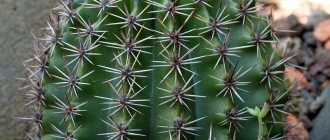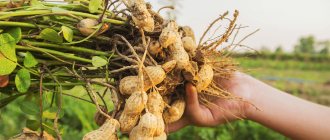Pomegranate, or Pomegranate (Punica), comes from the family Lythraceae, which contains only two species of low deciduous trees and shrubs.
It received its Russian name from the Latin word granatus (grainy), due to the peculiar granular structure of the fruit, and its generic name - punica - from the place of original growth (from Latin punicus - Punic or Carthaginian, the region of modern Tunisia). It is an abundantly branching woody plant with thin, short, irregular, angular shoots covered with light grey-brown bark. The leaves are small, short-petioled, opposite or collected in whorls of a couple of pieces. Moreover, in such “assemblies” any two opposite sheets are much larger than the rest. The leaf blade is slightly wavy and smooth-edged. Its shape varies from elliptical to lanceolate. The upper side of the leaf is glossy, leathery, the lower side is matte, with a clearly defined central vein.
The flowers are apical, funnel-shaped, with very short pedicels, often solitary, but sometimes collected in few-flowered inflorescences. The calyx is thick, leathery, fleshy, with 5 - 7 sepals, fused approximately 2/3 of its length. Their free part is triangular-lanceolate, arched towards the peduncle. The corolla is six-petalled. Petals are broadly oval, wrinkled. The stamens are short, numerous, with small bright yellow anthers. Fruits are produced only by those flowers whose cup shape resembles a jug - with a thickening at the base. Often bell-shaped flowers are sterile.
The fruits themselves, called pomegranates, are a large spherical multi-seeded berry with a thick leathery red-brown pericarp, divided inside into 6 - 12 chambers. In some varieties, individual fruits can exceed 15 cm in diameter and contain up to 1500 large seeds, placed in burgundy-red capsules filled with juice.
In its natural habitat, flowering continues all year round and both flowers and ripe fruits can be found on the plant at the same time.
Where and how does pomegranate grow in nature?
Pomegranate has several names: pomegranate, pomegranate tree. It belongs to the Derbennikov family. It produces recognizable fruits, which, due to their characteristics, are classified as a special type of pomegranate.
Pomegranates grow along the Mediterranean coast - in Southern Europe and North Africa, and in Asia they are distributed mainly in the western regions up to the Himalayan mountains. Thus, it is a tropical plant that is found in a wide range from 40° south to 45° north latitude.
THIS IS INTERESTING
The Latin name of pomegranate punicus is translated as Punic or Carthaginian, since this tree grows in North Africa, where the state of Carthage was located in ancient times.
About the beneficial properties of pomegranate
A lot is known and said about the benefits of pomegranate. It contains a variety of vitamins, organic substances and microelements that have a good effect on different organ systems and the body as a whole:
- vitamin C improves immunity;
- vitamin P helps strengthen the tissues of the walls of blood vessels;
- group vitamins ensure metabolic processes and improve hematopoiesis;
- tannins have a bactericidal effect.
The main benefits of pomegranate are optimizing blood flow, strengthening the strength of blood vessels, thereby improving heart rate and stabilizing blood pressure.
Description of dwarf decorative varieties of pomegranate
In nature, the pomegranate tree grows up to 5-6 meters. However, special decorative varieties are grown at home, which, due to their size, are called dwarf. They generally grow between 80-120 cm. The leaves are small, oval-shaped with a pleasant gloss. They have a bright light green color.
An interesting detail is that the foliage almost constantly changes its color. When the growth period begins in the spring, they are more saturated bronze tones, and during the summer they manage to acquire rich green tones. By autumn they turn yellow, like most of the trees we are used to.
Variety of species
At home, pomegranate is often grown due to its decorative appearance and long flowering period. Among flower growers, the following dwarf varieties of shrubs are most popular:
Nana. The height of an adult plant reaches one meter. This variety is an exact copy of a garden tree.
- Carthage is dwarf. Shrub with small leaves and scarlet flowers. The fruits are very small, up to 5 cm in diameter, juicy and sour.
- Baby. The height of the flower does not exceed half a meter. The leaves have an elongated shape and are located on the branches in small bunches. The flowers are very large, with long petals of a bright red hue, and can be single or collected in inflorescences. The light brown fruits are set only after artificial pollination.
- Ruby. A low, compact tree that gets its name from the rich dark red color of its flowers.
- Uzbekistan. A low-growing variety of garden pomegranate, up to two meters high. It is distinguished by medium-sized fruits with a sweet taste. Very often this variety is grown at home as an ornamental plant.
Many gardeners grow trees from the seeds of fruit purchased in the store. Such plants do not retain varietal characteristics and do not bear fruit. The main difference between decorative varieties and garden varieties is the preservation of foliage in winter and a more attractive appearance.
How to grow indoor pomegranate (video)
The flowers are bright red, larger in size than the foliage, so they look good against their background. They are elongated, cone-shaped and live only a few days. However, over the course of the season, new buds are constantly formed, thanks to which the pomegranate bush almost constantly decorates the room. Fruits are formed only in 4-5 flowers out of a hundred. Moreover, if the fruit has begun to form, then the flowers continue to appear on the bush, which creates a very beautiful, elegant look.
Currently, quite a few varieties of dwarf pomegranate have been developed. The most famous are the following:
- Nana (nana) grows up to 100-110 cm, has graceful, proportional forms;
- Baby is a very graceful plant that grows to a size of no more than half a meter;
- Ruby is slightly larger than baby ruby, its flowers have a classic bright red color;
- Uzbekistan is a real giant, as it can grow up to 2 meters in height. Produces fruits with a sweet and sour flavor.
Cold-resistant pomegranate varieties for growing in the garden
A pomegranate bush can be grown not only at home, but also in the garden. To do this, you need to choose special winter-hardy varieties:
- gulyusha grow up to 2-2.5 meters in height, have a spreading crown, due to which they are used in garden landscape design. Resistant to frost down to –15°C.
- Ak Don Crimean is also resistant to Russian climatic conditions. The variety forms a small tree that needs to be pruned in time to achieve a beautiful bush shape. It is cultivated for fruit production in Central Asia, where it was bred.
Winter-hardy pomegranate varieties take root well in the climatic conditions of Central Russia, but most often they do not bloom. To cultivate them, mandatory protection will be required during the winter cold period, since they may not withstand frosts below -15°C.
Varieties of indoor, decorative pomegranate
The following varieties are used for growing indoors:
- An ordinary pomegranate, grown at home from a seed bought at the market. In open ground the tree can reach 5-6 m; in a room it will not grow more than 1 m. Even with optimal lighting and care, it does not always bloom and bear fruit. However, it will decorate with its appearance with dense, narrow, glossy leaves.
- The “Uzbekistan” variety can also grow in the garden in southern latitudes and in the home greenhouse. No more than 2 m in height. It blooms with pink flowers, the fruits are beautiful red in color, and have a very pleasant taste.
- Variety "Ruby". Received its name because of the color of the fruit. It is interesting that on the plant you can simultaneously see all stages of fruit development, from the bud to the finished “grenade”.
- The next copy is "Nana". No more than 1 m tall. Develops well, blooms and bears fruit on the window!
- “Baby” is a very tiny (by pomegranate standards) plant. Up to 50 cm in height. The flowers are arranged in groups of several. The fruits are orange or brown.
How does pomegranate reproduce?
Pomegranate can be propagated in several ways, the easiest of which is using cuttings.
Growing pomegranate from seeds
To propagate pomegranate by seeds, you need to select the ripest fruits (ornamental bush or ordinary tree), extract the berries from them, crush them and plant them shallowly (1 cm) in the soil, the composition of which is described in the corresponding section.
There is experience of successfully growing pomegranate from seeds and in ordinary soil suitable for indoor flowers. important to provide them with sufficiently warm conditions (not lower than 22°C) and to water them well. The first leaves appear after 1.5-2 months. As soon as there are 3-4 of them, you can transplant them into a separate small pot (take about 400 g of soil). It is important to understand that pomegranate grown from seeds may lose some varietal characteristics.
Plant propagation by cuttings
The technology of propagation by cuttings is not only the simplest, but also very effective. All work is carried out in the fall:
- It is better to take the youngest shoots (one or two years old).
- All leaves, branches, thorns and dry parts are removed.
- Then they are tied into a bundle and the bundle is placed at the bottom of a pre-dug hole (about half a meter deep).
- Cover the top with a large layer of straw (30 cm) and sprinkle a little earth.
- Next year, when the soil has completely thawed, you need to remove the shoots, remove those that have withered, and cut several 15-20 cm cuttings from the rest.
- Cuttings should be planted only in heated soil, and 12 hours before planting they should be kept in water.
It is even easier to cut indoor varieties of pomegranates - in February, the non-lignified shoot is cut off and treated with root, after which it should be germinated in a damp mixture of peat and sand. When the 4th leaf begins to appear, you can plant it in a regular pot.
Cuttings of pomegranate (video)
Reproduction by grafting
There are several types of vaccinations:
- under the bark;
- splitting the handle (so-called splitting);
- budding - i.e. sleeping eye grafting.
All methods, except the last one, are used in early spring, and budding in September. The cutting should be taken from a young shoot, 15-20 cm in size. It is better to insert it from the north side - direct sunlight should not penetrate the grafting site during the entire time of merging.
Reproduction of decorative pomegranate at home
There are the following methods for propagating pomegranate:
- seeds;
- cuttings;
- layering;
- vaccination;
Propagation of pomegranate by seeds
If you want to grow an indoor pomegranate yourself or give a gift to your loved ones by growing a tree seedling, then the first two methods are most often used.
To grow pomegranate from seed:
- choose a large fruit, perhaps from a garden variety; in the room it will become dwarf;
- free the seeds from the pulp;
- rinse them and dry them a little;
- plant in an enriched peat-sand mixture to a depth of 2-2.5 cm;
- water daily;
- shoots will appear in 1-1.5 months.
At first these will be thin, like strings of plants, but within 2-3 months the future small, home-grown tree will already be formed.
Propagation of decorative pomegranate by cuttings
Many crops are propagated by cuttings. Cuttings are cut young shoots with 3-4 active buds.
The sequence is as follows: branches are cut at an angle;
Treated with a special solution to improve root formation (Kornevin, Kornerost and others);
Planted deep into the ground so that 1-2 buds remain;
Cover with a jar;
Rooting occurs within 1-1.5 months. Then the plant is transplanted into a pot in which it will grow for the first year of its life.
Layering and grafting of decorative pomegranate
The other two methods are used less frequently.
This is when layering is done to produce a new plant. This method is used if there are low-lying shoots. They are sprinkled, leaving a few buds and pressed down to improve contact with the ground. A new tree can be transplanted after 2 months.
In some cases, vaccinations can be used. It is possible to combine a sprig from an existing pomegranate with another plant.
This method is acceptable only within one species of these plants, because pomegranate does not want to take root with other plants.
How to grow indoor pomegranate from seeds at home
It is quite possible to grow a homemade pomegranate from a seed; you just need to take into account several features of this method of propagation.
Selection and preparation of pomegranate seeds for planting
First of all, you need to choose the right pomegranate fruit. You can take decorative fruits, or ordinary ones, which are purchased in the store. The technique is as follows:
- You need to take very ripe or overripe fruit.
- Pull out a few berries and crush the pulp with your fingers.
- Feel how hard the seeds are - only the hardest ones will do.
- Before planting, all the pulp must be washed off with plenty of water, otherwise they will rot, and the sprouts will disappear along with them.
- The planting should be shallow - maximum 1 cm.
THIS IS INTERESTING
Contrary to popular belief, the germination rate of pomegranate seeds reaches 90-95%, but it can take a long time before a sprout appears - sometimes up to a year.
Soil and flower pot for growing pomegranate on the windowsill
The soil contains equal amounts of the following types of soil:
- sheet;
- peat;
- turf;
- humus.
It is acceptable to use universal soil for indoor plants or special soil for citrus trees. The main thing is that the earth has a neutral reaction.
Important! The bottom must be drained - you can put coarse sand and small stones.
Initially, the grain can be planted in a small container, and then transplanted into a regular flower pot. For decorative growing purposes, you need to choose small containers, because when the roots become crowded, the bush will produce a lot of flowers. There are no fundamental requirements for the material.
Pinching and transplanting pomegranate sprouts into a flower pot
Up to 4-5 years of life, the developing bush should be replanted annually. Then it can be replanted every three years. In all cases, it is better to do the procedure in early spring. Each subsequent pot in diameter should be 4-5 cm larger than the previous one.
You need to take care of the formation of a beautiful crown in the early stages of development, since a young pomegranate produces many shoots at the beginning of its life. You need to pinch the top shoots so that the crown is sufficiently spreading. You should also limit the growth of those branches that grow too rapidly.
Caring for pomegranate at home
The pomegranate bush is a rather unpretentious plant; caring for it will not take much time:
- It is optimal to choose windows in the west or east so that the sun's rays do not directly hit the foliage for a long time.
- During the spring, nitrogen fertilizer should be applied monthly - it is especially important to do this for young bushes that grow quickly.
- Watering in summer is abundant, daily, in winter - 1-2 times a week. Also, during the warm period, it is better to constantly spray the leaves - pomegranate loves moisture.
- During wintering, pomegranates should not be disturbed with fertilizers. It needs to be moved to a cooler place (16-18°C is acceptable).
- In the summer, a young bush can be transplanted into your garden, but it is better not to disturb adult plants with transplants.
Replanting decorative pomegranate at home
In the first years, it is necessary to replant the plant. This is how you can grow a decorative pomegranate at home, taking care of it.
up to 4 years of age.
The growing plant is transplanted into a container (flower pot) that is somewhat larger in volume. However, it should be remembered that the root system should not be too free, because in such conditions the number of infertile flowers increases. The freer the roots, the more single flowers there are.
At four years the last replanting is carried out, then only the surface layer of soil is changed.
Growing pomegranate trees in open ground
In our latitudes, growing a pomegranate tree in open ground has a number of features related to preparing the plant for wintering.
Where and how to plant pomegranate seedlings in the garden
Since pomegranate loves light, it is unacceptable to place it in the shade - then it will gradually begin to fade. However, intense, scorching heat should also be avoided. Therefore, the optimal place is next to garden trees (apple tree, bird cherry), which provide good partial shade and at the same time leave plenty of space for the rays to pass through.
A hole is dug according to the size of the root, rotted manure and old foliage mixed with sand are poured into it (layer 20 cm). The roots of the seedling need to be well straightened and planted, sprinkled with soil. You need to water immediately and generously. When the bush takes root, it is necessary to create mulch from manure around it.
Important! If possible, it is better to plant the bush on a small hill, since pomegranate does not like an excessively moist environment - in this case, the roots may rot.
Watering and fertilizing the plant
Watering is weekly - if the bush is large, then with a standard bucket of water (10 l). It must be left to room temperature. If the summer is dry, water more often or more. It is important to remember that pomegranate is harmed not only by a lack of moisture, but also by excess moisture. If the leaves begin to fall off, most likely the bush is not getting enough moisture.
Fertilizing should be done at the very end of spring by adding mineral fertilizer. If you regularly (1-2 times a month) apply organic fertilizers (humus, mullein, chicken droppings) during the season, the bush will grow much faster.
Pomegranate trimming
To form a beautiful crown, you need to leave 4-5 trunks. You can do this in spring or autumn. All dried shoots must be removed throughout the season. It is also necessary to remove root shoots - they take a lot of moisture and nutrients.
How to care for a pomegranate tree during flowering and fruit formation
If the plant is well cared for (primarily, this is due to watering and fertilizers), then it can bloom in the first 2 years. During flowering and ovary formation, cooler water (18°C) should be used for irrigation. important to slightly reduce the usual volumes (by a quarter) of moisture. Before the formation of the ovary, superphosphate fertilizer must be added to the soil.
Preparing pomegranate for winter
In our latitudes, covering the bush for the winter is a prerequisite. All work is carried out in October, before the first frost:
- The branches are bent to the ground in 1 row and pinned with staples.
- Polyethylene is placed on top of them and also fixed.
- Next comes a layer of earth (20-30 cm).
Important! The stems of the bush must be treated with a 3% solution of Bordeaux mixture or another fungicide so that they are not attacked by microscopic fungi.
Changing the location of the decorative pomegranate
In summer, indoor trees can be placed in the garden so that they can breathe better and can enjoy natural light and the warmth of the sun.
It is good to time the transplantation of young plants to coincide with this season. Then, when transplanting into open ground, and in the fall again into a flower pot, the trees go through the stages of hardening. After this, they bloom and bear fruit better.
Decorative pomegranate does not require much care at home. Of course, to improve the condition of the plant, to bloom wildly and then bear fruit, you need to make an effort. You should be patient and, most importantly, already at the level of a seed or small seedling, fall in love with the future resident of the indoor greenhouse.
An adult tree will give many positive emotions with beautiful flowering and perhaps even fruiting. After all, its fruits are edible and do not differ in taste from those grown in the garden. And the flowers make a wonderful drink.
Growing a dwarf pomegranate is not labor-intensive, but there is special care required to grow a pomegranate at home...
Problems when growing pomegranate
If you do not follow the care conditions, the pomegranate will almost immediately respond with external signs of deviation from the norm.
Falling and yellowing of leaves
If the leaves begin to fall off and turn yellow, this may be a consequence of 3 reasons:
- insufficient watering and humidity levels in the air;
- lack of fertilizers;
- location of the bush in a heavily shaded place.
Important! Pomegranate is a deciduous plant, so yellowing and falling off of flowers in the fall is normal.
Why doesn't pomegranate bloom?
This is one of the most common problems. The most likely reason is the lack of sufficient fertilizer . They need to be applied at least 2 times a month during the warm season.
Also, the reasons may be related to a lack of light - in this case, it is important to analyze the condition of the foliage. If it is lethargic and turns yellow, it means that the plant is not receiving enough sunlight.
Pomegranate tree diseases and their treatment
Pomegranate diseases are associated with yellowing and loss of leaves, absence of flowers or ovaries. There is also a specific disease. due to the fact that the branches of the plant begin to peel off and die. It is called branch cancer and is manifested by cracked bark and the appearance of foreign formations; In addition, the branches begin to dry out in large numbers. All diseased shoots should be removed immediately.
Pomegranate pests and their control
There are several dangerous insects for this bush:
- The pomegranate moth damages fruits by laying its eggs in them. Such fruits must be immediately removed and destroyed, and any insecticides are suitable to combat the butterfly.
- Pomegranate aphid - especially likes to feed on young, non-lignified branches. To combat it, the tree is sprayed with an infusion of tobacco and soap (ratio 10:1).
- Mealybug.
- Spider mites leave whitish webs on branches and leaves. These insects are also controlled using universal insecticides.











